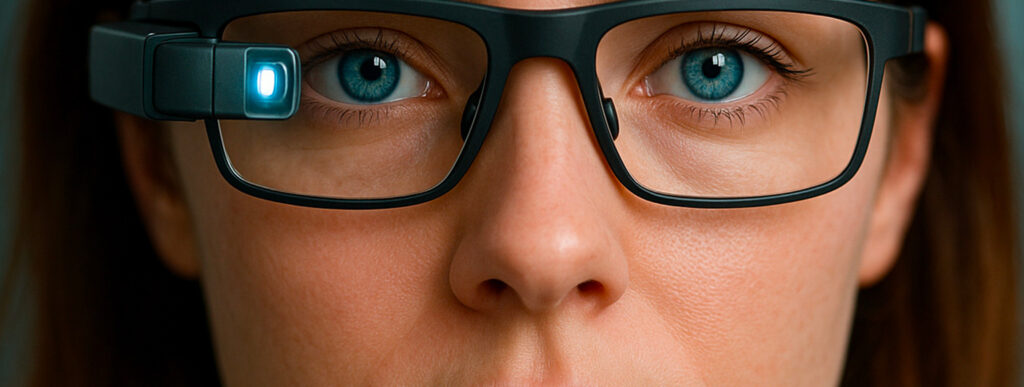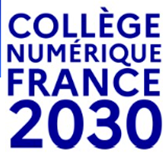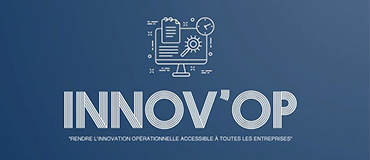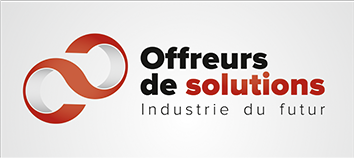Smartglasses, with augmented reality, incorporating artificial intelligence, image, audio and/or haptic feedback….
These connected glasses have in common transparent lenses and the possibility to see the real world, and they integrate advanced technologies; although smartglasses have been in existence for a number of years, they are now experiencing a rapid growth.
Smartglasses
Smartglasses

The spectrum of smartglasses
There is now a large number of products with or without screen, monocular or binocular, from «AI» (artificial intelligence) glasses to augmented reality glasses, covering a wide range of usages.
Companies around the world are heavily investing in the research and development of smart glasses, pushing the boundaries of wearable technology. Recent developments include devices with enhanced voice recognition capabilities, intuitive user interfaces and augmented reality systems that superimpose digital information on the real world.
Smartglasses models now cater to a broad spectrum of market requirements, ranging from consumer products to highly specialized versions for vertical professional sectors such as surgery and the nuclear industry.
AI smartglasses:
These glasses typically feature an integrated camera along with essential functionalities. They include built-in loudspeakers and microphones and are powered by advanced generative artificial intelligence.
The camera is capable of taking photos and videos, but it can also analyse the world around the user and answer questions about what they see (this feature is not allowed in some countries, due to GDPR).
In contrast to the Ray-Ban Meta and similar products that dominate the market, certain models now incorporate monochrome screens, typically in head-up display, monocular, or binocular configurations.
The market is very dynamic with a large number of models and is expanding rapidly.
Use cases
• Answer the phone
• Real-time translation
• Prompter
• Photos/videos
• Conversational AI
Monocular smartglasses /Heads Up Displays:
The primary focus of this category is monocular products, frequently with a Head Up Display (HUD). They are designed for specific use cases where a simple and small display is sufficient.
The products feature a display, which is typically opaque and resembles a small remote screen. It is often placed in front of the eye or at the end of an adjustable arm that allows for optimal positioning.
These materials are lightweight, easy to use, and mostly rugged to meet the needs of their main market, the industry.
Use cases
• Work instructions
• Logistics pickup
Basic Augmented Reality (AR) smartglasses:
These glasses feature a colour display and function as secondary screens, showing texts, images, and videos over the real world. While newer models offer anchoring with varying stability, many do not.
These products resemble eyeglasses in form and weight but are packed with technologies and functionalities. They are perfect for quickly displaying information without disrupting the user’s primary tasks.
There are various types of glasses designed for general consumer use, as well as for professionals experiencing “space computing.” Additionally, new opportunities are emerging with the introduction of more advanced models tailored for specific applications, such as providing subtitles in theatres.
Use cases
• Movies/videos
• Computer secondary display
Advanced Augmented Reality (AR) smartglasses:
Augmented reality glasses incorporate sensors and cameras that enable the glasses to overlay digital elements onto the real world with a high level of precision.
These products are typically high-end and more costly, primarily found in professional settings that require this level of efficiency for applications with practical use value.
These glasses enable users to access critical data while maintaining hands-free operation for their tasks. They are especially valued in design and engineering, industrial applications, and medical fields, where the precise real-time display of 3D data overlaid on the physical environment significantly enhances work efficiency and accuracy.
Use cases
• Quality control
• Support for task completion
• Remote assistance
• Design and engineering
What about other materials? Virtual reality, mixed reality helmets….
Reapse Consulting also examines other “glasses” products, including virtual reality (VR) headsets, which immerse users in a completely digital environment, separate from the physical world. Some VR headset manufacturers now provide the capability to view the surroundings through cameras integrated into the headset, similar to a phone. This feature enables applications and uses in “passthrough” AR, also known as mixed reality.
The most developed use cases are video games for the general public, and training in professional environments.

How can Reapse Consulting help you?
The lead consultant has ten years of experience at a smart glasses manufacturer and has developed considerable expertise and a strong network over the past 15 years, along with a large, qualified database. She attends CES in Las Vegas annually to review new products and joined the SILMO Circle of Experts in 2024 to enhance connections within the optical industry.
Smartglasses manufacturers: We offer benchmark reviews, specification analysis, risk and opportunity evaluations. We also help identify use cases with proven ROI or adjust specifications based on user and terrain needs.
Entreprises: We provide comprehensive insights into product offerings and the state of the art, including benchmarks, comparisons, and analyses of strengths and weaknesses. You can rely on us to help you understand the challenges and identify the best models for your specific use cases.
Optics industry: We promote acculturation and education while also fostering connections among stakeholders within both ecosystems. Our efforts facilitate the establishment of bridges between the sectors of optics, opticians, manufacturers, and the connected glasses industry.










